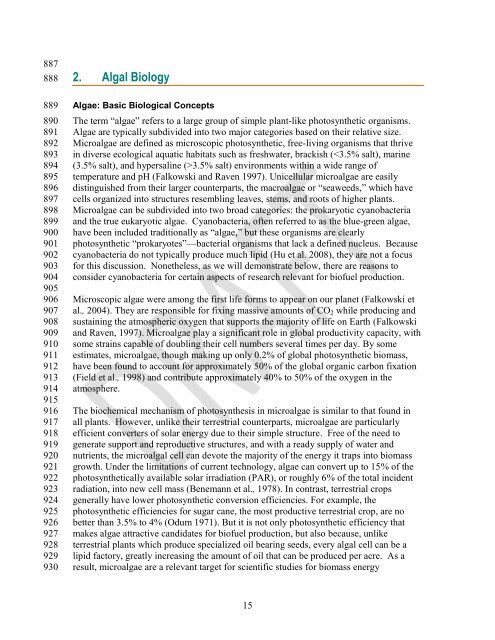Download the Algal Biofuels Roadmap draft document - Sandia
Download the Algal Biofuels Roadmap draft document - Sandia
Download the Algal Biofuels Roadmap draft document - Sandia
You also want an ePaper? Increase the reach of your titles
YUMPU automatically turns print PDFs into web optimized ePapers that Google loves.
887<br />
888<br />
889<br />
890<br />
891<br />
892<br />
893<br />
894<br />
895<br />
896<br />
897<br />
898<br />
899<br />
900<br />
901<br />
902<br />
903<br />
904<br />
905<br />
906<br />
907<br />
908<br />
909<br />
910<br />
911<br />
912<br />
913<br />
914<br />
915<br />
916<br />
917<br />
918<br />
919<br />
920<br />
921<br />
922<br />
923<br />
924<br />
925<br />
926<br />
927<br />
928<br />
929<br />
930<br />
2. <strong>Algal</strong> Biology<br />
Algae: Basic Biological Concepts<br />
The term ―algae‖ refers to a large group of simple plant-like photosyn<strong>the</strong>tic organisms.<br />
Algae are typically subdivided into two major categories based on <strong>the</strong>ir relative size.<br />
Microalgae are defined as microscopic photosyn<strong>the</strong>tic, free-living organisms that thrive<br />
in diverse ecological aquatic habitats such as freshwater, brackish (3.5% salt) environments within a wide range of<br />
temperature and pH (Falkowski and Raven 1997). Unicellular microalgae are easily<br />
distinguished from <strong>the</strong>ir larger counterparts, <strong>the</strong> macroalgae or ―seaweeds,‖ which have<br />
cells organized into structures resembling leaves, stems, and roots of higher plants.<br />
Microalgae can be subdivided into two broad categories: <strong>the</strong> prokaryotic cyanobacteria<br />
and <strong>the</strong> true eukaryotic algae. Cyanobacteria, often referred to as <strong>the</strong> blue-green algae,<br />
have been included traditionally as ―algae,‖ but <strong>the</strong>se organisms are clearly<br />
photosyn<strong>the</strong>tic ―prokaryotes‖—bacterial organisms that lack a defined nucleus. Because<br />
cyanobacteria do not typically produce much lipid (Hu et al. 2008), <strong>the</strong>y are not a focus<br />
for this discussion. None<strong>the</strong>less, as we will demonstrate below, <strong>the</strong>re are reasons to<br />
consider cyanobacteria for certain aspects of research relevant for biofuel production.<br />
Microscopic algae were among <strong>the</strong> first life forms to appear on our planet (Falkowski et<br />
al., 2004). They are responsible for fixing massive amounts of CO2 while producing and<br />
sustaining <strong>the</strong> atmospheric oxygen that supports <strong>the</strong> majority of life on Earth (Falkowski<br />
and Raven, 1997). Microalgae play a significant role in global productivity capacity, with<br />
some strains capable of doubling <strong>the</strong>ir cell numbers several times per day. By some<br />
estimates, microalgae, though making up only 0.2% of global photosyn<strong>the</strong>tic biomass,<br />
have been found to account for approximately 50% of <strong>the</strong> global organic carbon fixation<br />
(Field et al., 1998) and contribute approximately 40% to 50% of <strong>the</strong> oxygen in <strong>the</strong><br />
atmosphere.<br />
The biochemical mechanism of photosyn<strong>the</strong>sis in microalgae is similar to that found in<br />
all plants. However, unlike <strong>the</strong>ir terrestrial counterparts, microalgae are particularly<br />
efficient converters of solar energy due to <strong>the</strong>ir simple structure. Free of <strong>the</strong> need to<br />
generate support and reproductive structures, and with a ready supply of water and<br />
nutrients, <strong>the</strong> microalgal cell can devote <strong>the</strong> majority of <strong>the</strong> energy it traps into biomass<br />
growth. Under <strong>the</strong> limitations of current technology, algae can convert up to 15% of <strong>the</strong><br />
photosyn<strong>the</strong>tically available solar irradiation (PAR), or roughly 6% of <strong>the</strong> total incident<br />
radiation, into new cell mass (Benemann et al., 1978). In contrast, terrestrial crops<br />
generally have lower photosyn<strong>the</strong>tic conversion efficiencies. For example, <strong>the</strong><br />
photosyn<strong>the</strong>tic efficiencies for sugar cane, <strong>the</strong> most productive terrestrial crop, are no<br />
better than 3.5% to 4% (Odum 1971). But it is not only photosyn<strong>the</strong>tic efficiency that<br />
makes algae attractive candidates for biofuel production, but also because, unlike<br />
terrestrial plants which produce specialized oil bearing seeds, every algal cell can be a<br />
lipid factory, greatly increasing <strong>the</strong> amount of oil that can be produced per acre. As a<br />
result, microalgae are a relevant target for scientific studies for biomass energy<br />
15


